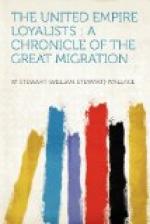Among the papers relating to the Loyalists in the Canadian Archives there is an abstract of the numbers of the settlers in the five townships at Cataraqui and the eight townships on the St Lawrence. There were altogether 1,568 men, 626 women, 1,492 children, and 90 servants, making a total of 3,776 persons. These were, of course, only the original settlers. As time went on others were added. Many of the soldiers had left their families in the States behind them, and these families now hastened to cross the border. A proclamation had been issued by the British government inviting those Loyalists who still remained in the States to assemble at certain places along the frontier, namely, at Isle aux Noix, at Sackett’s Harbour, at Oswego, and at Niagara. The favourite route was the old trail from the Mohawk valley to Oswego, where was stationed a detachment of the 34th regiment. From Oswego these refugees crossed to Cataraqui. ‘Loyalists,’ wrote an officer at Cataraqui in the summer of 1784, ’are coming in daily across the lake.’ To accommodate these new settlers three more townships had to be mapped out at the west end of the Bay of Quinte.
For the first few years the Cataraqui settlers had a severe struggle for existence. Most of them arrived in 1784, too late to attempt to sow fall wheat; and it was several seasons before their crops became nearly adequate for food. The difficulties of transportation up the St Lawrence rendered the arrival of supplies irregular and uncertain. Cut off as they were from civilization by the St Lawrence rapids, they were in a much less advantageous position than the great majority of the Nova Scotia and New Brunswick settlers, who were situated near the sea-coast. They had no money, and as the government refused to send them specie, they were compelled to fall back on barter as a means of trade, with the result that all trade was local and trivial. In the autumn of 1787 the crops failed, and in 1788 famine stalked through the land. There are many legends about what was known as ’the hungry year.’ If we are to believe local tradition, some of the settlers actually died of starvation. In the family papers of one family is to be found a story about an old couple who were saved from starvation only by the pigeons which they were able to knock over. A member of another family testifies: ’We had the luxury of a cow which the family brought with them, and had it not been for this domestic boon, all would have perished in the year of scarcity.’ Two hundred acre lots were sold for a few pounds of flour. A valuable cow, in one case, was sold for eight bushels of potatoes; a three-year-old horse was exchanged for half a hundredweight of flour. Bran was used for making cakes; and leeks, buds of trees, and even leaves, were ground into food.




